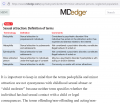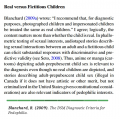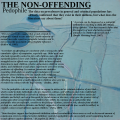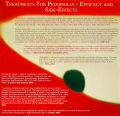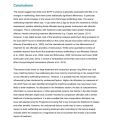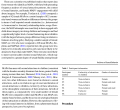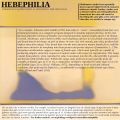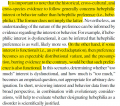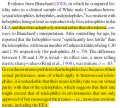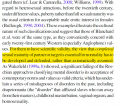Research: Psychopathy and abnormal psychology: Difference between revisions
The Admins (talk | contribs) bal |
|||
| (3 intermediate revisions by the same user not shown) | |||
| Line 52: | Line 52: | ||
*:"Here, we provide robust meta-analytic evidence that brain activity is not generally altered in pedophilia but deviates specifically in response to sexual stimuli." | *:"Here, we provide robust meta-analytic evidence that brain activity is not generally altered in pedophilia but deviates specifically in response to sexual stimuli." | ||
*'''Mundy, C. L. (2020). [https://open.library.ubc.ca/soa/cIRcle/collections/ubctheses/24/items/1.0394716 Shifting the focus : a multimethod exploration of resiliency among child-attracted persons] (T). ''University of British Columbia''.''' | |||
::"[C]hild-attracted persons in my sample [n=116] exhibited higher levels of honesty-humility, agreeableness, and altruism than the university students. Conceptually, this makes sense, as child-attracted persons who exhibit pro-social personality characteristics, such as honesty-humility, are likely more resilient to engaging in sexual offending behaviours due to a higher level of morality." | |||
===So-called "perturbation" theory=== | ===So-called "perturbation" theory=== | ||
| Line 80: | Line 82: | ||
*:"[C]onviction status for sexual offenses among pedohebephilic men was linked to higher rates of [sexual experiences], physical neglect, and physical abuse." | *:"[C]onviction status for sexual offenses among pedohebephilic men was linked to higher rates of [sexual experiences], physical neglect, and physical abuse." | ||
*: “While Study 1 and 2 found differences between teleiophilic and pedohebephilic men regarding instances of different types of sexual and nonsexual maltreatment, these were usually small or, as in the case of physical neglect or abuse in Study 2, even in the opposite direction from what was expected (and again small). Hence, in the present studies, pedohebephilic men’s early adverse family experiences did not differ markedly from those of teleiophilic men” | *: “While Study 1 and 2 found differences between teleiophilic and pedohebephilic men regarding instances of different types of sexual and nonsexual maltreatment, these were usually small or, as in the case of physical neglect or abuse in Study 2, even in the opposite direction from what was expected (and again small). Hence, in the present studies, pedohebephilic men’s early adverse family experiences did not differ markedly from those of teleiophilic men” | ||
*'''McPhail, I.V. (2024) “[https://link.springer.com/article/10.1007/s11930-023-00381-y The Subjective Experience of Individuals with Pedohebephilic Interest]”, ''Current Sexual Health Reports'' 16, DOI: 10.1007/s11930-023-00381-y''' | |||
*:from the [https://www.b4uact.org/b4qr/vol4/spring2024/ B4QR] description of the article: | |||
*:"Notably, studies have found higher rates of childhood adversities, including sexual abuse, among MAPs compared to the general population. [...] The biogenic pathway suggests early markers of developmental issues, such as young parental age at birth, lower parental education, parental criminality, and substance use, predict attraction to minors in adulthood. Some studies associate physical markers, including higher rates of congenital malformations, low Apgar scores, low birth weight, and being small for gestational age, with behavioral proxies for attraction to minors. However, McPhail notes that other studies have not found such correlations." | |||
===Adult-Adult relationships of MAPs=== | ===Adult-Adult relationships of MAPs=== | ||
| Line 87: | Line 93: | ||
===Multiple paraphilias?=== | ===Multiple paraphilias?=== | ||
Some studies found correlations between minor attraction and other "paraphilias". | |||
*'''McPhail, I.V. (2024) “[https://link.springer.com/article/10.1007/s11930-023-00381-y The Subjective Experience of Individuals with Pedohebephilic Interest]”, ''Current Sexual Health Reports'' 16, DOI: 10.1007/s11930-023-00381-y''' | |||
*:"Individuals who report pedohebephilic interests are also more likely to report other paraphilias, such as scatologia, zoophilia, sadism, urophilia, frotteurism, exhibitionism, and voyeurism [46, 89, 90]." | |||
However other paraphilias may tend to occur together more consistently. | |||
*'''Fedora O., Reddon J. R., Morrison J. W., Fedora S. K., Pascoe, H., & Yeudall, L. T. (1992). "Sadism and other paraphilias in normal controls and sex offenders," ''Archives of Sexual Behavior'', 21(1), 1-15.''' | *'''Fedora O., Reddon J. R., Morrison J. W., Fedora S. K., Pascoe, H., & Yeudall, L. T. (1992). "Sadism and other paraphilias in normal controls and sex offenders," ''Archives of Sexual Behavior'', 21(1), 1-15.''' | ||
*:"Pedophilia had a low incidence of co-occurrence with other paraphilias whereas sadism, transvestism, fetishism, and the courtship disorder paraphilias had a high incidence of co-occurrence. [...] These results suggest that pedophilia occurred alone much more frequently than did the other paraphilias." [Of subjects who responded most to children, 90.9% of non-offenders, 84.7% of sexually non-aggressive offenders, and 50% of sexually aggressive offenders showed no other paraphilia.] | *:"Pedophilia had a low incidence of co-occurrence with other paraphilias whereas sadism, transvestism, fetishism, and the courtship disorder paraphilias had a high incidence of co-occurrence. [...] These results suggest that pedophilia occurred alone much more frequently than did the other paraphilias." [Of subjects who responded most to children, 90.9% of non-offenders, 84.7% of sexually non-aggressive offenders, and 50% of sexually aggressive offenders showed no other paraphilia.] | ||
Revision as of 16:51, 10 December 2024
 | ||||||||||||
| Part of NewgonWiki's research project | ||||||||||||
|---|---|---|---|---|---|---|---|---|---|---|---|---|
|
| ||||||||||||
| ||||||||||||
|
| ||||||||||||
| Template: Research - This template |
Non-criminal populations of pedophiles do not exhibit increased levels of psychopathy or other pathologies,[1] nor less typical psychological characteristics such as left-handedness or paraphilia. One study even found lower levels of psychopathology.
Regarding MAPs, we are at a stage similar to homosexuality in the 1940s, 50s and 60s and for similar reasons.[2][3][4][5][6] As the APA now admit:
- "until the 1950's, most homosexual persons studied by psychologists and others were prisoners or mental patients, so it was easy to conclude that these were linked. Evelyn Hooker, a brave psychologist at University of California, Los Angeles (UCLA), began undoing this belief in the early 1950s. A gay former student told her, "Evelyn, it is your scientific duty to study men like me." Hooker agreed, "He's right — we know nothing about them." (cited in Burr, 1993). When she told the psychiatry department chair she wanted to study normal homosexuals, he replied, "There is no such person!" (Hooker, 1993, p. 450)."[7]
Associated characteristics
- For the discredited "lack of intelligence" theory based upon unrepresentative criminal sampling, see Offender Characteristics.
- Goudreault, M. (2017). Study of the psychological and physiological characteristics of a community sample of pedophiles. Thesis for Doctorate in clinical psychology.
- NewgonWiki: Goudreault compared a community sample of 190 male pedophiles with a control group composed of 151 males from the general population. Goudreault found that:
- "Differences between pedophiles and controls reached statistical significance for psychopathic traits, with pedophiles displaying fewer psychopathic traits compared to controls. These results contradict the findings of the large majority of studies using forensic and clinical samples of pedophiles."
- Strassberg et al. (2012). Psychopathy among pedophilic and nonpedophilic child molesters. Child Abuse & Neglect 36 (2012) 379–382.
- "Objective: Among men who commit sexual offenses against children, at least 2 distinct groups can be identified on the basis of the age of the primary targets of their sexual interest; pedophiles and nonpedophiles.
- Method: In the present report, across 2 independent samples of both types of child molesters as well as controls, a total of 104 men (53 pedophilic and 51 nonpedophilic) who had sexually offended against a child age 13 or younger were compared to each other (and to 49 non-sex offender controls) on psychopathy as assessed by the Psychopathic Personality Inventory (PPI).
- Results: In both samples of child molesters, the nonpedophiles scored as significantly more psychopathic than the pedophiles."
- Wilson, Glenn & Cox, David (1983). The Child-Lovers: A Study of Paedophiles in Society. London: Peter Owen Publishers. (webarchive copy)
- "The psychoticism score of the paedophiles [in our study] is slightly elevated compared with controls, but not drastically so, and certainly not to the extent that they could be called pathological as a group. There are several occupational groups listed in the Manual that have P[sychoticism] scores of approximately the same order, including actors, apprentices, architects, doctors, drivers, students and welfare officers, none of which could be regarded as clinically psychotic as a whole. Thus, there is no reason on the basis of these results to suppose that men with paedophile sexual preferences are necessarily marked by any exceptional degree of thought disorder. [...]
- The neuroticism scores of the paedophiles are again slightly higher than controls but not to an extent that would justify describing them as clinically abnormal. Among groups of men with similar N[euroticism] scores according to the Manual are actors, apprentices, machinists and students, and a great many of the female groups given in the Manual show N scores that are higher than these male paedophiles. [...]
- Perhaps the most striking thing about these results is how normal the paedophiles appear to be according to their scores on these major personality dimensions - particularly the two that are most clinically relevant (N[euroticism] and P[sychoticism]). The only marked characteristic of the PIE [Paedophile Information Exchange] members with respect to these major dimensions is their tendency to introversion, and this in itself is not usually thought of as pathological. Furthermore, the fact that the Lie Scale scores of the paedophiles are not distinguishable from those of controls would suggest that, overall, they were not bent on creating an artificially favourable impression on the questionnaire, but were giving an honest and accurate self-report. [...]
- Obsessionality, as indicated by this particular item from the EPQ does not seem to be characteristic of the paedophiles; in fact, the proportion endorsing this item is lower than that for controls. [...]
- Our results are also consistent with previous findings in failing to discover any obvious links between paedophilia and aggressive or psychotic symptoms (Quinsey, 1977).[...]
- Finally, our research revealed that the fantasies of paedophile men have a lot in common with those of normal men[...] When all these factors are considered it is clear that the sexual preferences of the paedophile are not so far removed from those of the normal man as they might at first appear."
- Schuler, M. et al (2019). "Empathy in pedophilia and sexual offending against children: A multifaceted approach," Journal of Abnormal Psychology, 128(5), 453–464.
- "Participants included 85 pedophilic men who committed hands-on child sexual offenses (P+CSO), 72 pedophilic men who never committed hands-on child sexual offenses (P−CSO), and 128 nonoffending teleiophilic male controls (TC). Several affective and cognitive aspects of empathy were assessed using the Multifaceted Empathy Test (MET) and the Interpersonal Reactivity Index (IRI). Whereas in self-reports (IRI) P+CSO scored lower than TC (P−CSO intermediate) in cognitive perspective-taking abilities, a performance-based measure (MET) revealed evidence for a better differentiation of emotional states in P−CSO as compared with P+CSO (TC intermediate). In addition, P+CSO and P−CSO showed significantly higher affective resonance while observing children (MET), which was paralleled by higher self-reported levels of personal distress in social situations (IRI). The results indicate evidence for higher general affective empathic resonance to children in pedophilic men but superior cognitive empathy abilities in nonoffending pedophiles only, which may act as a protective factor in the prevention of sexual offending."
- Berlin, F. S. (2000). "Treatments to change sexual orientation," The American Journal of Psychiatry, 157, 5.
- "Individuals whose sexual orientation is directed toward children manifest the same range of personality, temperamental, and character traits as individuals whose sexual orientation is directed towards adults. A recent Journal article documented that the vast majority of individuals with pedophilia showed no evidence of either antisocial or narcissistic personality disorder."
- Whittaker, J. Wilson (2007). "A comparison of neurocognitive functioning in pedophilic child molesters, nonpedophilic child molesters and normal adult males," pp. 7-8. Ph.D. dissertation, The University of Utah.
- "Post hoc testing revealed significantly greater psychopathy among nonpedophilic child molesters in comparison to pedophiles on the Psychopathic Deviate Scale (p = .026), and a trend in the regard to the group differences on the Mac-R that suggested nonpedophilic offenders had more severe scores on the Mac-R than did pedophiles. Scores for [community sample] controls fell in between the two groups in regard to psychopathy on both the PDS and the Mac-R (see Table 3). These differences suggest that psychopathic traits were more prevalent among nonpedophilic child molesters (and possibly controls) than among pedophiles. At first blush, this finding appears inconsistent with much of the current literature on pedophiles, who have often been characterized as largely psychopathic (Dorr, 1998; Firestone, Bradford, Greenberg & Serran, 2000). However, there are at least two possible explanations for this discrepancy. First, considering the percentage of our controls with reported substance abuse histories (35%), and who had been incarcerated (26%) (national average is 4.1%) (US Census Bureau, 2005), there is a clear indication that the control group was not an accurate representation of the "normal" population, possibly being more psychopathic than would be expected. Second, pedophiles may actually be less psychopathic than formerly believed. In the previous studies of psychopathy in pedophilia (Dorr, 1998, 2000; Firestone, Bradford, Greenberg & Serran, 2000; Porter et al., 2000) the researchers failed to divide child molesters into pedophilic and nonpedophilic groups. As a consequence, psychopathy may have been a phenomenon factually associated with nonpedophilic offenders and wrongly associated with pedophiles."
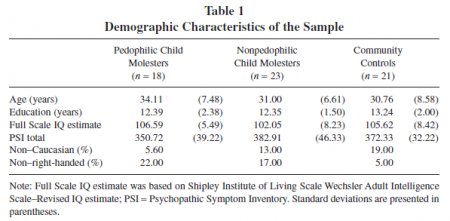
- Suchy, Yana; Whittaker, Wilson J.; Strassberg, Donald S.; Eastvold, Angela (2009). "Facial and Prosodic Affect Recognition Among Pedophilic and Nonpedophilic Criminal Child Molesters," Sexual Abuse: A Journal of Research and Treatment, 21(1), 93-110.
- NewgonWiki: Pedophilic child molesters scored significantly lower (350.72) on a Psychopathic Symptom Inventory than both non-pedophilic child molesters (382.91) and community controls (372.33).
- Schiffer, Boris and Vonlaufen, Corinne (2011). "Executive Dysfunctions in Pedophilic and Nonpedophilic Child Molesters", The Journal of Sexual Medicine, 8(7), pp. 1975-1984.
- "Results indicate that pedophilic child molesters exhibited less performance deficits in cognitive functioning than nonpedophilic child molesters. Compared to healthy controls and nonsexual offenders, the pedophilic child molesters only showed executive dysfunction concerning response inhibition, whereas the nonpedophilic child molesters revealed more severe dysfunction, especially on tasks associated with cognitive flexibility and verbal memory. [...]
- "Both the nonpedophilic child molesters and the nonsexual offenders showed significant performance deficits on both subtasks of the verbal memory task (immediate and delayed recall) compared to healthy controls, whereas pedophilic child molesters did not. As previous studies could show that deficits in verbal memory were associated with aggressive behavior, it seems reasonable that pedophilic child molesters showed no or less deficits on this task. In the end, pedophilic child molesters were rather characterized by a nonviolent offense style, whereas nonpedophilic child molesters and nonsexual offenders revealed stronger aggressive tendencies through their offenses. [...]
- "We found that nonpedophilic child molesters showed the worst performance of all four groups in all tested cognitive functions even though not all reached significance regarding group comparison statistics. Nevertheless, we found that different types of offenders are characterized by different deficit profiles among the tested executive functions. Our results support the hypothesis that nonpedophilic child molesters show more comprehensive performance deficits in executive functions than pedophilic child molesters. However, a majority of the neuropsychological deficits, in particular those associated with verbal (memory) skills, seem to be associated with criminality or violence rather than pedophilia."
- Ponseti, J. et al. (2018). "Decoding Pedophilia: Increased Anterior Insula Response to Infant Animal Pictures," Frontiers in Human Neuroscience, 23 January 2018.
- "In order to study nurturing processing independent from sexual processing we exposed our pedophilic and teleiophilic subjects during an fMRI-session to pictures of infant and adult animals because these images were not perceived as sexually arousing. We found an increased neural response to pictures of infant animals in pedophiles. [...] Taken together, the pedophilic subjects of the present study showed an over-responding to infant animal stimuli in a network of brain regions that contribute to motivating behaviors. This is in accordance with our hypothesis that nurturing stimuli receive additional processing resources in pedophiles. It is of interest that some of the areas of increased response to infant animals are related to the mating domain. The left anterior insula, being a crucial area of nurturing processing, was also frequently found to be activated in sexual brain studies (Stoleru et al., 2012). Furthermore, the left anterior insula (as well as the SMA) is a constituent of the human attachment system, thereby enabling both nurturing and pair-bonding (Feldman, 2016). Based on both observations, (i) the over-responding to nurturing stimuli in various motivational areas and (ii) the functional overlap of nurturing and sexual processing of the involved left anterior insula a tentative and simple model of pedophilia could be as follows: Nurturing stimuli receive additional processing resources by mating-circuits. In case of human infant stimuli this leads to a sexual connotation of infant stimuli. This idea is supported by the suggestion that nurturing and pair-bonding are two closely inter-related domains in humans at the level of physiological functions, brain processing, and involved neuropeptides (Feldman, 2016). Interestingly, more than two decades ago, the Austrian ethologist Eibl-Eibesfeldt expressed a similar view suggesting that pedophilia might in some cases be based on an “eroticization of parental love” (Eibl-Eibesfeldt, 1990)."
- Schnellbächer, G.J., Dukart, J., Hansen, J.Y. et al. (2023) Aberrant brain activity in pedophilia links to receptor distribution, gene expression, and behavior. Nat. Mental Health 1, 615–622 .doi:10.1038/s44220-023-00105-0
- "Here, we provide robust meta-analytic evidence that brain activity is not generally altered in pedophilia but deviates specifically in response to sexual stimuli."
- Mundy, C. L. (2020). Shifting the focus : a multimethod exploration of resiliency among child-attracted persons (T). University of British Columbia.
- "[C]hild-attracted persons in my sample [n=116] exhibited higher levels of honesty-humility, agreeableness, and altruism than the university students. Conceptually, this makes sense, as child-attracted persons who exhibit pro-social personality characteristics, such as honesty-humility, are likely more resilient to engaging in sexual offending behaviours due to a higher level of morality."
So-called "perturbation" theory
James Cantor, Ray Blanchard and others have since 2002,[8] made various assertions re. brain functioning/structure (linked to early brain traumas), left handedness and reduced stature in "pedophiles" or "pedohebephiles" identified within unrepresentative criminal samples. These theories tend to fall apart when researchers look at broader samples.
- Joyal, C.C. (2022). The neuroanatomical bases of pedophilia and the importance of distinguishing genuine vs. acquired types: A systematic review Sexual Offending: Theory, Research, Prevention, DOI: 10.23668/psycharchives.5571
- “Three main neurobiological theories currently attempt to explain pedophilic offending (not to be confounded with nonoffending pedophilia): the frontal-dysexecutive model, the temporal-limbic model, and the dual-dysfunctional theory (Dillien et al., 2020). [...] As stressed by a growing number of authors, however, these theories explain hypersexuality and disinhibition, but not pedophilic interests per se (Caffo et al., 2021; Jordan et al., 2020; Kruger & Kneer, 2021). In view of the present results, the same conclusion can be drawn about acquired pedophilia. Interestingly, a recent brain imaging meta-analysis based on 436 men with a pedophilic disorder failed to find any structural difference compared with 449 controls (Scarpazza et al., 2021). Therefore, anomalies of fronto-temporal regions appear to be more closely associated with child sexual abuse (acting out) than pedophilia (Dillien et al., 2020).”
- Jahnke et al. (2021): Neurodevelopmental Differences, Pedohebephilia, and Sexual Offending: Findings from Two Online Surveys.Archives of Sexual Behavior (Preprint).
- "The neurodevelopmental theory of pedohebephilia states that sexual interests in children arise from early neurodevelopmental perturbations, as, for example, evidenced by increased non-right-handedness, more childhood head injuries, and reduced intelligence and height. As corroborating evidence largely rests on samples of convicted men, we conducted online surveys among German-speaking (Study 1, N = 199) and English-speaking men (Study 2, N = 632), specifically targeting community members with pedohebephilic or teleiophilic interests. Although we detected theoretically meaningful sexual interest patterns in an embedded viewing time task, we could not detect expected neurodevelopmental differences between teleiophilic and pedohebephilic men in any of the two studies. Strikingly, pedohebephilic men who reported convictions for sexual offences emerged as smaller and less intelligent than pedohebephilic men without convictions in Study 2."
- Polisois-Keating, A., & Joyal, C. C. (2013). Functional Neuroimaging of Sexual Arousal: A Preliminary Meta-Analysis Comparing Pedophilic to Non-Pedophilic Men. Archives of Sexual Behavior, 42(7), 1111–1113.
- "The goal of this preliminary study was to explore whether the nature and magnitude of regional brain activation associated with sexual arousal differed between pedophilic and non-pedophilic men when each group was exposed to their preferential sexual stimuli. Although based on only 123 participants, the pattern of activation did not seem to differ significantly between the groups. All activated brain regions associated with sexual arousal in the non-pedophilic group were also found in the pedophilic group and no significant differences emerged between the groups; however, the number of significant foci was higher in the pedophilic group."
- Stein, Clara C., Julian Packheiser, and Marietta Papadatou-Pastou (2023). Meta-analysis on the association between handedness and pedophilia Preprint.
- "Pedophilia is a sexual preference disorder that has been linked to neurodevelopmental alterations in diagnosed individuals. One common biomarker for atypical neurodevelopment are elevated levels of atypical handedness as individuals with several neurodevelopmental disorders show increased levels of left or mixed hand preference. Few primary studies have indicated that atypical handedness could also be more prevalent in pedophilia. However, individual studies are prone to sampling biases and a comprehensive synthesis of the literature on this topic is still missing. In this pre-registered study, we performed a meta-analysis on k = 13 studies that were searched in PubMed, Web of Science and Google Scholar (until January 2023). These 13 studies measured hand preference in n = 1194 individuals with pedophilia and n = 5648 controls. Contrasting previous evidence from individual research reports, we found evidence against higher rates of atypical handedness irrespective of handedness classification using frequentist and robust Bayesian meta-analyses. There was no evidence of publication bias across analyses. These results suggest that atypical handedness is not suited to serve as a biomarker for pedophilia."
Adverse childhood
Some studies indicate a link between adverse childhood (nonsexual) experiences and attraction to minors, although cause and effect has not been established by these correlational studies. Assuming there is causality, it should be noted that what happens as a result of adverse events may not be a malfunction, but an evolutionarily conditioned adaptation. To see in detail how childhood sexual experience relates to later attraction, see the section abused-abuser relationship
- Marx CM, Tibubos AN, Brähler E, Beutel ME. Experienced childhood maltreatment in a sample of pedophiles: comparisons with patients of a psychosomatic outpatient clinic and the general population. J Sex Med. 2020;17:985–93. doi:10. 1016/j.jsxm.2020.01.019.
- “Emotional and sexual abuse was associated with pedophilic sexual preference.” [...] “Our results speak to a burdened and stressful childhood of patients with pedophilia; a fantasized, sexualized world in an abusive and neglecting childhood may function as a refuge and lead to “psychic withdrawal”.”
- Jahnke S., Schmidt, A.F., Hoyer, J. (2022). Pedohebephilia and Perceived Non-coercive Childhood Sexual Experiences: Two Non-matched Case-Control Studies. Sexual Abuse: A Journal of Research and Treatment, DOI:10.1177/10790632221098341.
- "[C]onviction status for sexual offenses among pedohebephilic men was linked to higher rates of [sexual experiences], physical neglect, and physical abuse."
- “While Study 1 and 2 found differences between teleiophilic and pedohebephilic men regarding instances of different types of sexual and nonsexual maltreatment, these were usually small or, as in the case of physical neglect or abuse in Study 2, even in the opposite direction from what was expected (and again small). Hence, in the present studies, pedohebephilic men’s early adverse family experiences did not differ markedly from those of teleiophilic men”
- McPhail, I.V. (2024) “The Subjective Experience of Individuals with Pedohebephilic Interest”, Current Sexual Health Reports 16, DOI: 10.1007/s11930-023-00381-y
- from the B4QR description of the article:
- "Notably, studies have found higher rates of childhood adversities, including sexual abuse, among MAPs compared to the general population. [...] The biogenic pathway suggests early markers of developmental issues, such as young parental age at birth, lower parental education, parental criminality, and substance use, predict attraction to minors in adulthood. Some studies associate physical markers, including higher rates of congenital malformations, low Apgar scores, low birth weight, and being small for gestational age, with behavioral proxies for attraction to minors. However, McPhail notes that other studies have not found such correlations."
Adult-Adult relationships of MAPs
- Mundy, C., Lewis, H., & Cioe J. (2021). "Romantic and Sexual Relationships with Adult Partners Among Pedohebephilic Men," Archives of Sexual Behavior, Preprint.
- B4U-ACT reviewer: "Overall, the researchers concluded that minor-attracted adults’ reasons for having or seeking romantic and sexual relationships with adults appear to parallel those of other sexual minority groups according to the exclusivity of their attraction to minors. Motivations of MAPs whose attractions are less exclusive appear similar to those of heterosexual individuals and sexual minority women, possibly due to a higher likelihood of falling in love with their partners. The motivations of those who are more exclusively attracted to minors appear to be similar to those of asexual adults; namely, to increase intimacy and achieve a sense of satisfaction in their relationships."
Multiple paraphilias?
Some studies found correlations between minor attraction and other "paraphilias".
- McPhail, I.V. (2024) “The Subjective Experience of Individuals with Pedohebephilic Interest”, Current Sexual Health Reports 16, DOI: 10.1007/s11930-023-00381-y
- "Individuals who report pedohebephilic interests are also more likely to report other paraphilias, such as scatologia, zoophilia, sadism, urophilia, frotteurism, exhibitionism, and voyeurism [46, 89, 90]."
However other paraphilias may tend to occur together more consistently.
- Fedora O., Reddon J. R., Morrison J. W., Fedora S. K., Pascoe, H., & Yeudall, L. T. (1992). "Sadism and other paraphilias in normal controls and sex offenders," Archives of Sexual Behavior, 21(1), 1-15.
- "Pedophilia had a low incidence of co-occurrence with other paraphilias whereas sadism, transvestism, fetishism, and the courtship disorder paraphilias had a high incidence of co-occurrence. [...] These results suggest that pedophilia occurred alone much more frequently than did the other paraphilias." [Of subjects who responded most to children, 90.9% of non-offenders, 84.7% of sexually non-aggressive offenders, and 50% of sexually aggressive offenders showed no other paraphilia.]
- Marshall, W. L., & Eccles, A. (1991). "Issues in clinical practice with sex offenders," Journal of Interpersonal Violence, 6, 69-70.
- "Related to the issue of diagnosis is the claim that sex offenders have multiple paraphilias (Abel & Rouleau, 1990). This particular study is worth considering in a bit more detail as its influence has been quite substantial, so much that the results are frequently cited as gospel. For instance, DSM III-R states that "people with a Paraphilia commonly suffer from several varieties: in clinical settings that specialize in the treatment of Paraphilias, people with these disorders have an average of from three to four different Paraphilias" (American Psychiatric Association, 1987, p. 280). Abel, Becker, Cunningham-Rathner, Mittelman, and Rouleau (1988) elicited self-reports from 561 subjects, some of whom reported engaging in more than one type of deviant sexual act. However, when we sum the number of subjects listed in their table, we find 1156 men, not just the original 561, are listed over the various categories. Our guess is that the way in which each patient's problems were tallied accounts for this discrepancy. It seems that when a man reported more than one deviant act (e.g., he reported raping an adult female and molesting a young boy) he was counted twice (i.e., once as a rapist with an extra deviance and once as a child molester with an extra deviance). This, of course, would artificially inflate the apparent number of multiple paraphiliacs, particularly when we note that some of Abel's patients reported 10 or more paraphilias. In addition, it is not clear what criteria were employed to decide that an extra deviance was present. Abel et al. (1988) use the term "multiple paraphilia" as if to imply that they strictly adhered to the DSM diagnostic criteria, and yet they could not have, because rape does not appear in the diagnostic manual. If a 50-year-old man reported that when he was a teenager he had once or twice engaged in a deviant act other than the one for which he was referred, would this count as an additional paraphilia? If so this would inflate the number of apparent multiple paraphiliacs in a way that would seem somewhat misleading."
Limitations of criminal studies
Characteristics of pedophiles are often found to be characteristics of the criminal populations used for the purpose of providing a sample. As mentioned above, these are similar to the methodological problems that plagued early studies of homosexuals.
- Green, R. (2002). "Is pedophilia a mental disorder?," Archives of Sexual Behavior, 31(6), 467-471.
- "A study of general personality features and concurrent psychopathology of pedophiles is hampered by sampling bias. Nearly all studies involve prisoners or those convicted of a criminal offence. These are doubtfully representative of all pedophiles who have contact with children and certainly not representative of pedophiles who confine their eroticism to fantasy and so do not break the law. Finkelhor et al. (1986) observed the following sampling bias in convicted sex offenders: “[They are] a small fraction of all offenders, the most flagrant and repetitive in offending, most socially disadvantaged, and least able to persuade criminal justice authorities to let them off” (p. 138)."
- Okami, P. & Goldberg, A. (1992). "Personality Correlates of Pedophilia: Are They Reliable Indicators?," Journal of Sex Research, 29(3), 297-328.
- Okami and Goldberg systematically reviewed the literature and found that pathology has not been reliably associated with pedophilia. They conclude: "The clearest finding of the present review is that relatively little may be stated about the personality or phenomenology of pedophiles [...] Looking at the very scanty data pertaining to pedophilia per se, then, we are unable to report any reliable findings. [...] as Wilson and Cox (1983) and several others have pointed out, the types of affective and social pathologies associated with samples of pedophiles ... seriously beg the question of causal direction. Guilt feelings, feelings of ostracism loneliness, low self-esteem, etc., clearly are exacerbated by, if not sequelae of, the social condition of pedophiles ... and should not be interpreted as representing etiological variables or intrinsic correlates of sexual preference for children. [...] For example, because an unknown percentage of true pedophiles may never act on their impulses or may never be arrested, forensic samples of sex offenders against minors clearly do not represent the population of "pedophiles," and many such persons apparently do not even belong to the population of "pedophiles.""
- Whittaker, J. Wilson (2007). "A comparison of neurocognitive functioning in pedophilic child molesters, nonpedophilic child molesters and normal adult males," pp. 35-36. Ph.D. dissertation, The University of Utah.
- "This conceptualization of the role of the frontal lobe as a moderator of sexual behavior is consistent with evidence from neurological injury studies in which frontal lobe damage is associated with generalized hypersexual behavior, rather than the manifestation of new targets of sexual interest (Lesniak, Szymusik, & Chrzanowski, 1972; Sabhesan & Natarjan, 1989; Stein, Solvason, Biggart, & Speigel, 1996; Tavares, 2000). Considered within the context of pedophilia, this suggests that pedophiles with frontal lobe damage may be at greater risk than pedophiles without such damage for acting upon their sexual interests, which increases the likelihood of their committing a crime, and subsequently increases the chance that they will be caught. The authors put forth the supposition that frontal lobe damage in pedophiles may also result in poor planning, difficulties inhibiting perseverative sexual thoughts, low frustration tolerance, inattention and impulsivity. It is argued that these traits would also likely predispose the offender to detection by law enforcement (Cohen et al., 2002; Stone & Thompson, 2001). Consequently, there exists the possibility that neuropsychological weaknesses evidenced in pedophiles may simply be an artifact associated with self-selection bias, such that pedophiles with neurocognitive weaknesses may be more likely to be caught (and therefore available as research participants) than pedophiles with normal neurocognitive function."
- Kärgel, C., et al. (2016). Evidence for superior neurobiological and behavioral inhibitory control abilities in non-offending as compared to offending pedophiles. Human Brain Mapping, 38(2), 1092–1104.
- "Using a go/nogo paradigm in combination with functional magnetic resonance imaging (fMRI) we compared behavioral performance and neural response patterns among three groups of men matched for age and IQ: pedophiles with (N 5 40) and without (N 5 37) a history of hands-on sexual offences against children as well as healthy non-offending controls (N 5 40). As compared to offending pedophiles, non-offending pedophiles exhibited superior inhibitory control as reflected by significantly lower rate of commission errors. Group-by-condition interaction analysis also revealed inhibition-related activation in the left posterior cingulate and the left superior frontal cortex that distinguished between offending and non-offending pedophiles, while no significant differences were found between pedophiles and healthy controls."
Is pedophilia a mental disorder?
The received clinical wisdom of pedophilia as mental disorder represents a blurring of moral-legal and medical definitions. There is no scientific basis for classifying pedophilia as a mental disorder when it does not cause marked problems for the pedophile or those who he or she interacts with.
- Green, R. (2002). "Is pedophilia a mental disorder?," Archives of Sexual Behavior, 31(6), 467-471.
- "Sexual arousal patterns to children are subjectively reported and physiologically demonstrable in a substantial minority of “normal” people. Historically, they have been common and accepted in varying cultures at varying times. This does not mean that they must be accepted culturally and legally today. The question is: Do they constitute a mental illness? Not unless we declare a lot of people in many cultures and in much of the past to be mentally ill. And certainly not by the criteria of DSM."
- Tromovitch, P. (2009). "Manufacturing Mental Disorder by Pathologizing Erotic Age Orientation: A Comment on Blanchard et al. (2008)," Archives of Sexual Behavior, 38(3), 328
- "Like masturbation and homosexuality, pedophilia (informally: erotic attraction to prepubescent people) appears to have entered the DSM as a "mental disorder" without any scientific or rational basis."
- Szasz, T. (2002). "Sins of the Fathers: Is child molestation a sickness or a crime?," Reason, Aug/Sep, 2002.
- "Crimes are acts we commit. Diseases are biological processes that happen to our bodies. Mixing these two concepts by defining behaviors we disapprove of as diseases is a bottomless source of confusion and corruption. [...] Geoghan himself has been convicted of molestation in one case and faces trial in another. But if his behavior was caused by "the disease of pedophilia," a condition that not only compelled him to fondle boys but erased his memory of those "diseased acts," how can it be just to punish him? [...] Today virtually any unwanted behavior, from shopaholism and kleptomania to sexaholism and pedophilia, may be defined as a disease whose diagnosis and treatment belong in the province of the medical system. Disease-making thus has become similar to lawmaking. [...] The entire psychiatric literature on what used to be called "sexual perversions" is permeated by the unfounded idea -- always implied, sometimes asserted -- that "abnormal" sexual impulses are harder to resist than "normal" ones."
- Haeberle, Erwin J. (2010). "Paraphilia - A Prescientific Concept," Magnus Hirschfeld Archive for Sexology.
- "Anyone who uses a term like 'paraphilia' thereby indirectly claims to know what is right and wrong in human sexual behavior. [...] To us modern sexologists, however, it should be clear by now that the Natural Law doctrine has no place in science. It should therefore be equally clear that the term 'disorder' is no longer acceptable when it comes to something as complex as human sexual behavior. Scientists should leave such moral certainty (better: dogmatism) to the religious authorities. In conclusion: We in sexology should, once and for all, get rid of the moralistic, prescientific terms 'paraphilia' and 'disorder'."
- Hinderliter, Andrew C. (2010). "Defining Paraphilia: Excluding Exclusion," Open Access Journal of Forensic Psychology, 2, 241–272.
- The author challenges a number of common arguments for retaining pedophilia in the DSM. "This leaves only the issue of pedophilia. The arguments considered so far render highly tenuous the basis of retaining it in the DSM, but the issue is complicated because there is a legitimate treatment issue involved—people distressed about their attraction to children wanting clinical help in resisting these desires should have access to such help. Whether the current state of this diagnosis is effective for promoting such treatment, especially in non-correctional populations, and how (and if) it could be modified to better support such treatment are important questions deserving further research and consideration (for concerns that these have not been taken seriously in the DSM revision process, see B4U-ACT, 2010). Even if pedophilia is kept in the DSM on the basis of pragmatic arguments about facilitation of treatment, this still leaves serious doubt about whether it is an appropriate diagnosis on which to base indefinite civil commitment."
- Malón, Agustin (2012). "Pedophilia: A Diagnosis in Search of a Disorder", Archives of Sexual Behavior, 41(5), pp. 1083-1097.
- "It has been shown, and many of the parties to the controversy would have no difficulty in agreeing, that some people with pedophilia apparently do not suffer as a result and that, in any event, such distress they may experience is rather the predictable result of conflict with society (Bernard, 1985; Howitt, 1995; Vogt, 2006; Wilson & Cox, 1983). [...]
- "Are men with pedophilia dangerous? If they are, in what way? Under what circumstances? Does their dangerousness depend on their erotic peculiarity or on their character? [...] Any assertion in this sense may be premature and incomplete, given the limited state of our current knowledge which rests largely on the evidence gleaned from very biased samples of subjects who have been imprisoned for criminal offences (Seto, 2008). And it has been suggested that "it is likely that the criminal offending requires additional individual risk factors separate from the paraphilic interest per se" (Langstrom, 2009, p. 2). [...]
- "In this sense, finally, we should consider the possibility of conceptualizing pedophilia as a very complex phenomenon that, contrary to other paraphilias, it is oriented towards another person and not to objects or animals, parts of the body or any kind of act. Its essence does not reside in exploitation, assault or harm to others, and some pedophiles look also for the child's friendship and love (Lautmann, 1994; Li, 1990; Schmidt, 2002; Seto, 2012). Regardless of the intense feelings of rejection that some of its manifestations generate in most of us, to conceptualize and discuss this condition in the same category with the compulsive necessity to show one's genitals to an unsuspecting stranger is contributing to an inadequate, ineffective, and confusing theory of human eroticism and its problems."
Excerpt Gallery Library
The gallery of graphics on characteristics contains some useful information on the myth of psychopathy.
-
A warning about the political nature of Psychiatry
-
Moser and Kleinpatz - Paraphilia is a questionable concept
-
Haeberle on paraphilia
-
Americal Psychiatric Assiciation's DSM-5 Manual says pedophilia can be an orientation
-
Charles Moser on the subsequent coverage and bumbling by the APA
-
DSM-5 another graphic
-
Some chronophilias
-
Seto - extended chronophilias
-
High Emotional Empathy (Schuler et al, 2019)
-
Mirkin on methodological flaws and gay analogy
-
Gaither: How does the idea of pedophilia as an orientation stand against the evidence?
-
Blanchard/DSM debate opinions on drawn material - relevant to Lolicon-MAP Equivalence Debate
-
Sociocultural perspective on pedophilia as a disorder - Chenier
-
Orientation or Disorder?
-
Development of pedophilia, choice and abused-abuser myths
-
The myth of psychopathy
-
Retarded or perturbed pedophile myth
-
Nonsexual aspects
-
Non-offending pedophilia and impulse control
-
The efficacy and consequences of attempts to treat Pedophiles
-
2017 UK Gov review of attempts to reform sex offenders via "treatment"
-
Dutch Rapporteur: "On Solid Ground" Prevalence of pedophilia in a criminal sample, broken down
-
Lievesley/Lapworth 2021 - State of play with female MAPs
-
Even in an online sample of MAPs (biased towards low AoAs), hebephilia is very common.
-
Hebephilia is also common in the gen-pop
-
Neoteny - a review (source unknown)
-
Rind and Yuill on adaptive hebephilia
-
Rind and Yuill (cont'd)
-
Rind and Yuill (cont'd)
-
Rind and Yuill (cont'd)
References
- ↑ B4U-ACT research summary
- ↑ Grygier, T. (1957). Psychometric Aspects of Homosexuality. Journal of Mental Science, 103(432), 514-526.
- ↑ AHRENFELDT RH. Homosexuality and sexual trauma. British Medical Journal. 1947 Nov;2(4532):795. DOI: 10.1136/bmj.2.4532.795-b
- ↑ GLUECK, B. C. (1956). PSYCHODYNAMIC PATTERNS IN THE HOMOSEXUAL SEX OFFENDER. American Journal of Psychiatry, 112(8), 584–590.
- ↑ STAFFORD-CLARK D. The medico-legal problem of homosexuality. The Medical Press. 1947 Sep;218(10):220-222. PMID: 20257970.
- ↑ Male Homosexual: Archive from the BBC in which homosexuals speak candidly of their "condition" in 1965
- ↑ APA - How psychology has helped society accept homosexuality
- ↑ Blanchard, R., Christensen, B. K., Strong, S. M., Cantor, J. M., Kuban, M. E., Klassen, P., … Blak, T. (2002). Archives of Sexual Behavior, 31(6), 511–526. doi:10.1023/a:1020659331965





